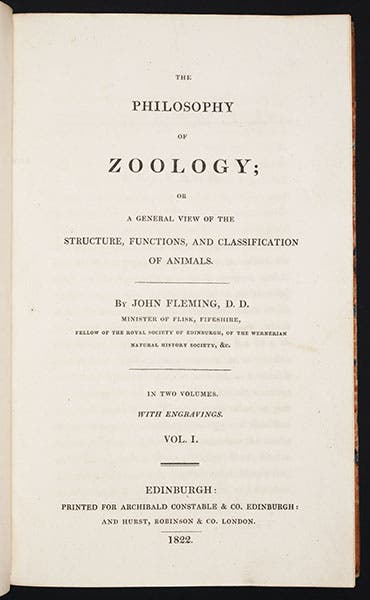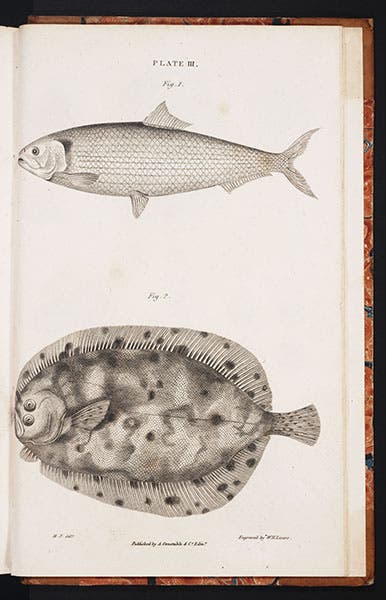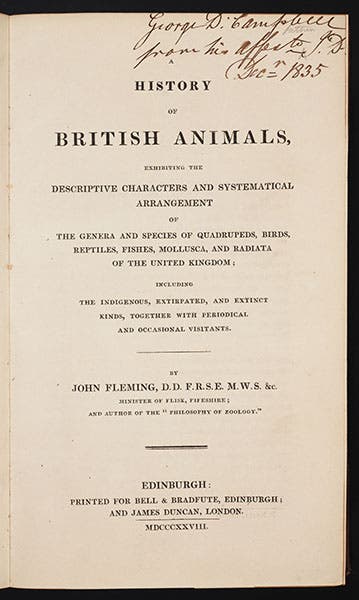Scientist of the Day - John Fleming
John Fleming, a Scottish naturalist and cleric, was born Jan. 10, 1785. Until he was nearly 50, Fleming was more clergyman than academic, presiding over the parish of Flisk in Fife. But he was a very active (and contentious) naturalist, and he came of age when the catastrophism of George Cuvier was acquiring many followers in Scotland and England. Cuvier had demonstrated that many animal species had become extinct, and he sought to explain those extinctions by worldwide geological revolutions, when flood waters wiped out many forms of life, laid down new strata, and made room for new species. Explaining geological and species changes by massive floods was called diluvialism. One of Cuvier’s English followers, William Buckland at Oxford, extended Cuvier's diluvialism to include the Biblical Flood, making that the last of the catastrophic events that shaped the Earth, and Buckland presented his Biblical diluvialism in his book, Reliquiae diluvianae (1823).
Fleming took issue with Cuvier and Buckland. He argued that it was perfectly possible for animals to become extinct because of small changes in the environment, or, in some cases, by the action of humans. Fleming was thus one of the first British naturalists to be concerned with the "economy of nature," or ecology, as we now call it. Even though he was a clergyman, he dismissed the Biblical flood as a geologic agent and maintained that natural history does not need any help from Scripture when it comes to understanding the past history of the Earth.
Fleming made his case first in The Philosophy of Zoology (1822; second image), before Buckland's book came out, and then in a series of articles in the Philosophical Magazine that issued from Edinburgh. He also argued that prehistoric life had changed more slowly than catastrophism allowed, and he had some impact on Charles Lyell, whose uniformitarian views would appear in his Principles of Geology (1830-33). Meanwhile, Fleming published his second major book, History of British Animals, in 1828 (fourth image). It is somewhat of a mystery why Cuvier, Buckland, and Lyell are so well known in the history of the natural sciences, and Fleming is not. Some historians lay the blame on Fleming’s argumentative nature, since he took up his pen readily to correct any perceived slight and seems to have alienated even his allies, such as Lyell. Still, it is noteworthy that Charles Darwin took a copy of The Philosophy of Zoology with him on the voyage of the Beagle (and did not take a copy of Buckland's Reliquiae diluvianae).
We have copies of both of Fleming's books in the Library. We show you two of the five plates in The Philosophy of Zoology (first and third images), not because they have anything to do with our discussion, but because they are attractive, and because they were drawn by his wife, Melville Christie, whom Fleming thanks in the preface. As was the case for many naturalists’ wives whose artistic abilities greatly aided their husband’s work, this was her sole mention in the literature of natural history.
There is a portrait of Fleming at the University of St. Andrews; he does indeed look somewhat combative (fifth image). John and Melville were buried in Dean Cemetery, Edinburgh, where a memorial stone still stands (sixth image).
Dr. William B. Ashworth, Jr., Consultant for the History of Science, Linda Hall Library and Associate Professor, Department of History, University of Missouri-Kansas City. Comments or corrections are welcome; please direct to ashworthw@umkc.edu.











